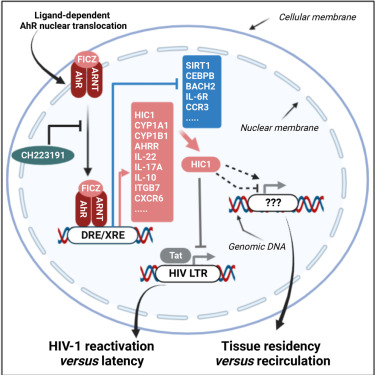Antiretroviral therapy (ART) has transformed HIV-1 infection into a manageable chronic disease and increased the life expectancy of people living with HIV-1 (PLWH). During antiretroviral therapy, HIV can quietly hide in a reservoir of CD4+ T lymphocytes, a special type of white blood cell that plays an important role in activating the body's immune system to fight infection. The existence of these viral sanctuaries may explain why antiretroviral therapy must be continued throughout a patient's life to prevent HIV from replicating. According to WHO data, by the end of 2021, more than 3,800 people worldwide will be infected with HIV.
Recently, in a research report titled "Identification of aryl hydrocarbon receptor as a barrier to HIV-1 infection and outgrowth in CD4+ T cells" published in the international journal Cell Reports, scientists from the University of Montreal and other institutions found that a special protein called aryl hydrocarbon receptor (AhR) may play a key role in HIV latency.
Professor Ancuta and others found that AhR may have an antiviral effect in CD4+ T cells in patients. AhR is a transcription factor that regulates the expression of specific genes. To help HIV remain silent in the reservoir cells, the AhR has an effect on the expression of the molecule HIC1, another transcription factor known to suppress HIV replication. To prove this, the researchers constructed CD4+ T AhR knockout cells using CRISPR-Cas9-mediated gene editing technology, while also using drugs to induce or block AhR activation. Using two approaches to neutralize AhR activity, the researchers observed signs of viral growth in CD4+ T cells from HIV-infected individuals and patients receiving antiretroviral therapy.
Subsequently, the researchers proposed to use drugs that inhibit the activity of AhR as a special clearance strategy of "shock and kill". Once reactivation occurs in the presence of AhR activators (shock phase), HIV-infected cells are then seen by the host's immune system and not targeted for killing. In certain types of cancerous tumors, the AhR pathway is activated by specific molecules from the environment, such as tobacco smoke, pollutants, or ligand molecules produced by gut microbes and cell metabolism, and the resulting anti-inflammatory Sexual activity can also block the body's adequate anti-tumor immune response.
Drugs that block AhR function have been used to fight cancer in clinical trials. In future studies, the researchers hope to test these inhibitors to see if they can eliminate HIV or significantly reduce the size of the viral reservoir in patients taking antiretroviral therapy. In order to better understand the molecular mechanism behind viral latency, researchers will continue to collaborate on research to validate this new type of therapeutic target.
“Now we have successfully revealed how the AhR pathway is activated in the cells of patients,” Dr. Ancuta said. “With the help of advanced technologies such as spatial transcriptomics, we hope to further describe the tissues of HIV-infected patients. This may help us to validate this therapeutic target in humans in the context of HIV.”
Reference
Chatterjee D, et al. Identification of aryl hydrocarbon receptor as a barrier to HIV-1 infection and outgrowth in CD4+ T cells. Cell reports, 2023, 42(6).


